Are you planning to spend three weeks in Japan and aren’t sure where to start travel planning? This customisable 3 week Japan itinerary will help you get started!
Planning your first trip to Japan can be pretty overwhelming! There is so much to see, and you may not quite know what to expect from a country like Japan. I felt the same way when I visited Japan for the very first time. Since then, I’ve been back so many times and now spend a few months in Japan every year.
Having travelled across a large chunk of the country, I put together this 3-week Japan itinerary for first-time visitors. I’ve included sights to see, routes to take, and where to stay, and you can copy it for free!
As part of this 3-week Japan itinerary, I’ll add different options you can use to customise this itinerary to fit your preferences. The red line of the itinerary follows the New Golden Route, but with the extra suggestions and options, you can make this Japan itinerary work for you without doing the same thing everybody else is doing.
Let’s take a look!
In This Travel Guide
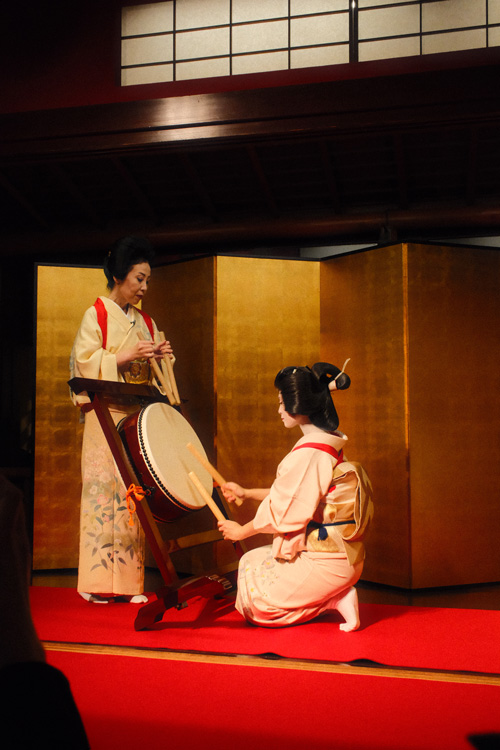
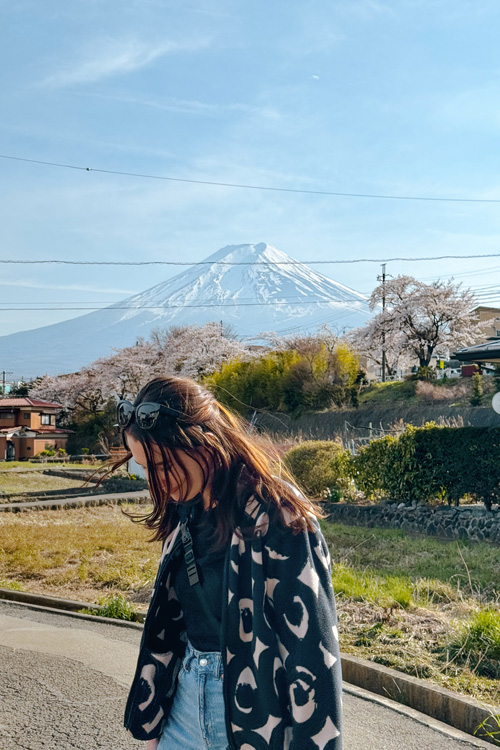
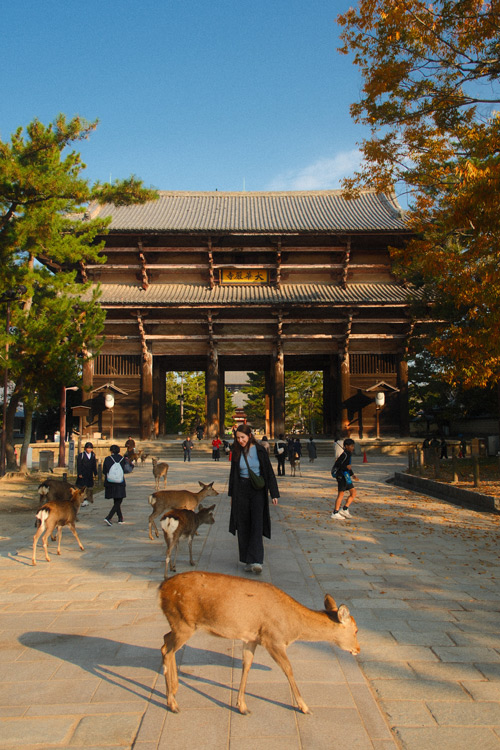
Spending three weeks in Japan as a first-time visitor is perfect. It gives you enough time to see the main highlights recommended in most itineraries, along with extra time to see some places that many visitors have to skip due to time constraints.
During my first trip to Japan, I spent 2 weeks following the Golden Route. Looking back, I wish I’d added an extra week to see more of the country. As I now spend a few months in Japan every year, I’ve got a pretty good idea of what to recommend friends and family when they’re visiting for the first time. I hope that this guide will do the same for you!
I understand that no itinerary fits all, so I want to give you options in this guide. While the 3 weeks in Japan below roughly follow the New Golden Route, I’ve added multiple options and suggestions for different day trips, stop-overs or overnight stays. That way, you can really make this Japan itinerary your own.
To avoid wasting too much time travelling between cities or moving your luggage, it’s best to book a few “home bases”. From there, you can take day trips using public transport. In the next section, I outline the cities that serve as a good base for this itinerary (excluding any optional overnight stays, for which hotel recommendations are listed in their own section).
You can use the interactive Google Maps below to help you navigate the full itinerary.
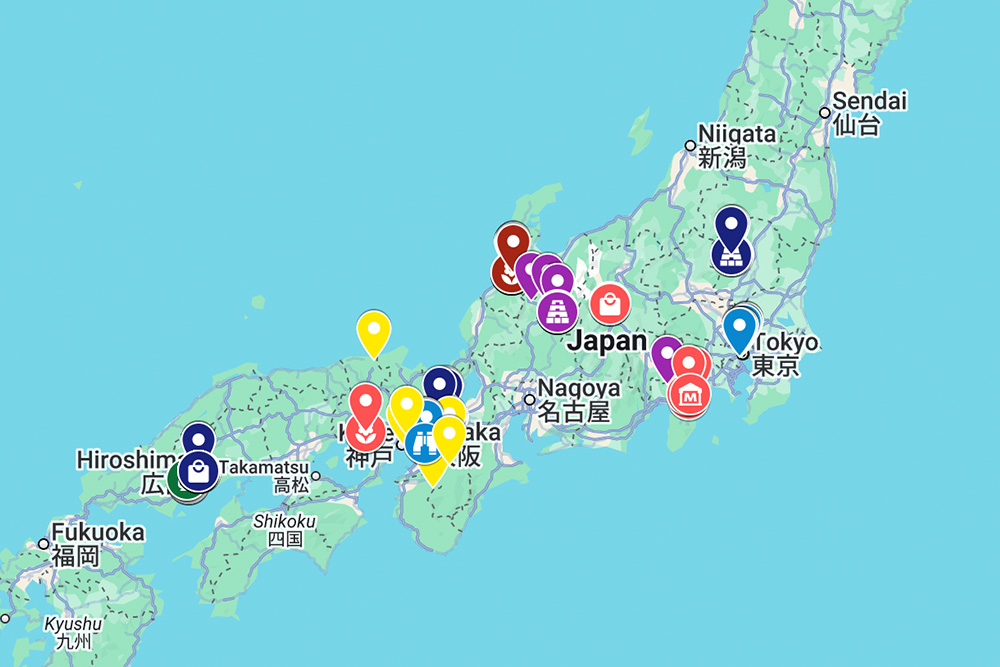
Click here for the interactive Google maps
 Stay: Booking.com
Stay: Booking.com
 Connectivity: Journey Japan eSIM | Wireless Japan Pocket WiFi
Connectivity: Journey Japan eSIM | Wireless Japan Pocket WiFi
 Transport: Individual Shinkansen Tickets | JR Passes | Airport Transfer
Transport: Individual Shinkansen Tickets | JR Passes | Airport Transfer
 Experiences: Klook | GetYourGuide
Experiences: Klook | GetYourGuide
 My Camera Gear: Fuji Film XT-5 | Sigma 18-50mm f2.8 | DJI Mini 4 Pro
My Camera Gear: Fuji Film XT-5 | Sigma 18-50mm f2.8 | DJI Mini 4 Pro
 Take me to a random hidden spot in Japan
Take me to a random hidden spot in Japan
 Support our free Japan guides by buying us a coffee! Thank you!
Support our free Japan guides by buying us a coffee! Thank you!
Moving hotels can take up a lot of time, and having to drag your suitcase from one place to the next isn’t ideal. So instead, it’s best to book a few “home bases” during your time in Japan. From there, you can easily explore the area or take day trips.
As briefly mentioned, this itinerary includes additional suggestions for day trips and overnight stays from some of these bases. I’ve added hotel recommendations in those sections, so you won’t find them in the block below.
Here is my 3-week Japan itinerary for first-time visitors. Please note the suggestions for day-trips or other spots you can replace to make this Japan itinerary your own. You can also feel free to copy it exactly the way it is:
As most international flights arrive in one of Tokyo’s two airports (Haneda or Narita), I’ve started this Japan itinerary in Tokyo. Haneda Airport is a bit closer to Tokyo than Narita Airport, but it’s easy enough to get to the city from both of them on public transport. Taxis are also widely available, or you can hire a private airport transfer.
We have separate guides on how to get to Tokyo from Haneda Airport or from Narita Airport with info on the options, prices and times.
To make travelling inside cities easier, it’s also a good idea to pick up an IC card, like Suica or Pasmo, as soon as possible. These IC cards are pre-paid e-money cards that make it easy to travel on public transport, use vending machines and pay at certain shops. You can also download a digital version on your phone (along with some other handy Japan travel apps).
The first few days of this itinerary are spent in and around Tokyo. It’s best to book your hotel in Tokyo for the first five nights.
I have a more in-depth guide on where to stay in Tokyo, which includes breakdowns of other areas, recommendations for different types of travellers and a host of other hotels I enjoyed staying in. For first-time visitors, I recommend the following hotels:

Park Hotel Tokyo
Tokyo is one of the biggest cities in the world, so three days will definitely not be enough to see everything! But it’ll give you a great first impression. Ideally, you pick one or two areas per day to explore, to avoid wasting too much time on public transport.
You can start by checking out my in-depth 6-day Tokyo itinerary. From the list, you can choose three of the days that speak to you most. Alternatively, you can check some of my highlighted suggestions below and put together your own itinerary:

Tokyo Tower

Kappabashi

Senso-ji Temple
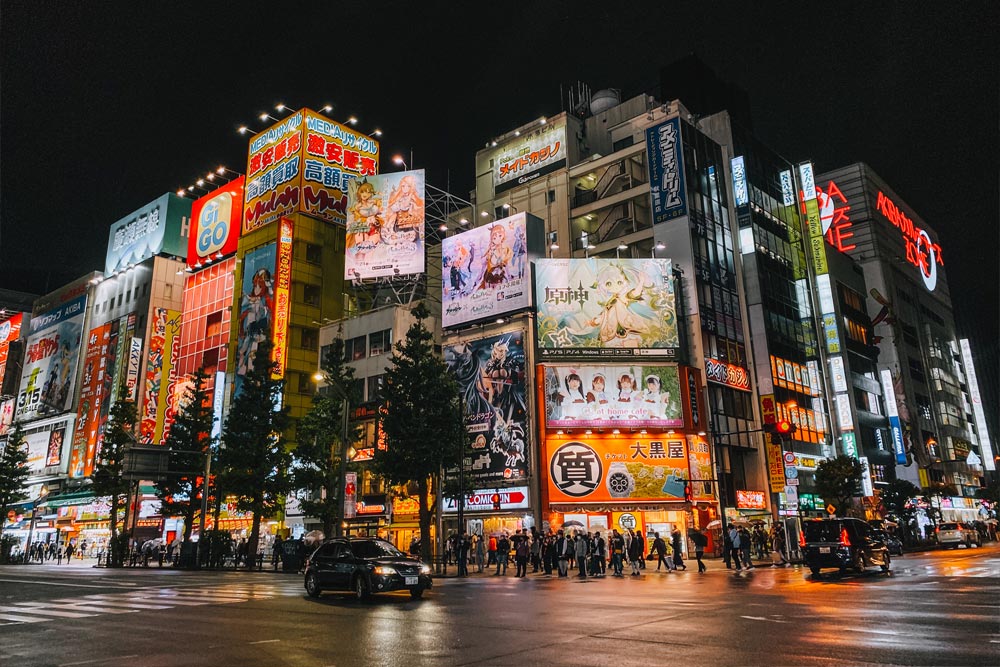
Akihabara at night
While you still have a hotel in Tokyo, you can use the next few days to take some day trips from Tokyo. As there are quite a few great day trip destinations from Tokyo, you can choose the ones that fit your interests best.
Below, I’ve listed some of my favourite day trips with information on how to get there and what to do. When spending three weeks in Japan, you’ve got time for two of them (or spend more time in Tokyo!) before heading to the next city on this itinerary.
Mount Fuji is undoubtedly one of the most famous spots to visit in Japan. Visiting the area around Mount Fuji to see the famous volcano in all its glory can be a great idea for your trip to Japan. Kawaguchiko is a popular place to see Mount Fuji for its striking views and relatively easy access from Tokyo via public transport.
One thing to keep in mind when planning a day trip to Mount Fuji during your three weeks in Japan is that it likes to hide in the clouds. Trying to pick the perfect day to visit can be tricky, especially when it’s hard to predict the visibility of Mount Fuji.
You’ve got the best chance of seeing Mount Fuji during winter (December – February) and in the morning/evening. If seeing it is an absolute must for you, you could also decide to stay overnight around Mount Fuji. You can check this website, which predicts visibility, but it only shows it for a few days.
One way to increase your chances of seeing Mount Fuji is to keep your days in and around Tokyo flexible. Once you get to Tokyo, you could check the weather forecast and pick a day to visit the Mount Fuji area. If that’s not possible, you can always risk it.
To get to Kawaguchiko from Tokyo, you can use the following travel routes:
We have a full guide on how to take a day trip to Mount Fuji from Tokyo with more information.


With views of Mount Fuji, hot springs, beautiful shrines and lush nature, Hakone is a popular day trip from Tokyo. You can get here in 1–1.5 hours on public transport. It has a special place in my heart, as it’s also the spot where my husband proposed to me.
Because Hakone has some beautiful traditional ryokans and hot springs, staying overnight is something you can consider. It’ll add a lot to your trip, but I understand that with limited time in Japan, you have to make choices. Either way, you can easily follow the Hakone Loop during a day trip and see the highlights of this lovely onsen town.
Here are the best things to do in Hakone when visiting for the day:
To save time and money, you should consider purchasing the Hakone Free Pass. This discount pass gives you a return ticket from Shinjuku to Hakone plus free travel inside the Hakone area (including the Pirate Ship and Ropeway). You can check out the full one day Hakone itinerary in our separate guide.

If you’d like to stay overnight in Hakone, it’s possible to travel from Hakone to Kyoto without having to make your way back to Tokyo first. To do so, make your way to Odawara Station from Hakone on the local train and then get the Shinkansen to Kyoto.

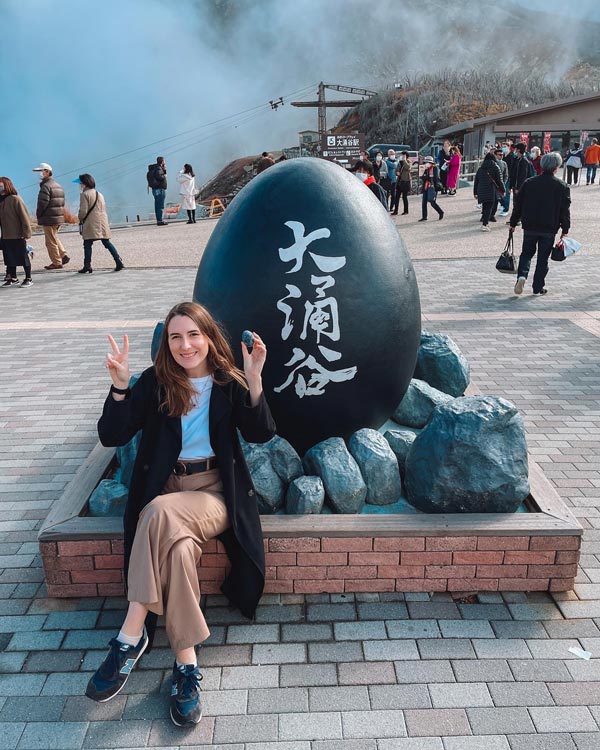
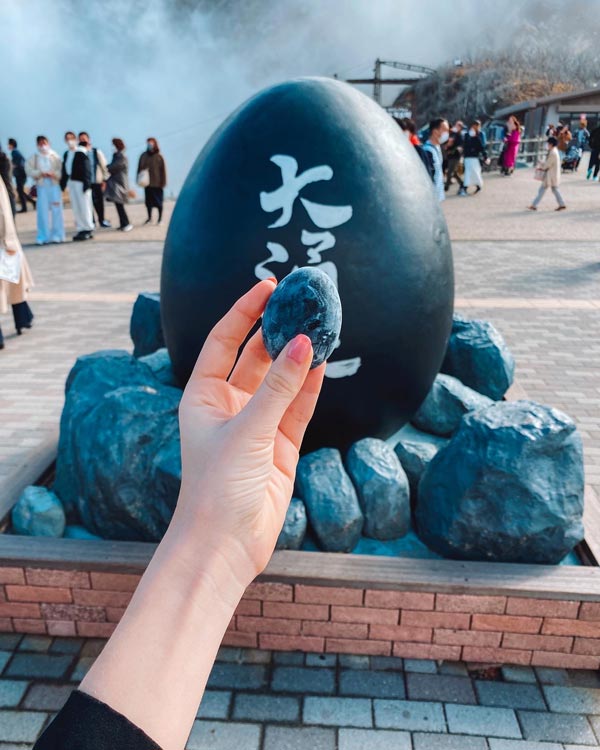
Nikko is a little further from Tokyo, but it is the perfect place for nature lovers. You can get there by train from Tokyo in around 2–3 hours. This mountain town sits in dense forest alongside some of the most beautiful shrines. A bit further from the main area, you can also find a stunning lake with hikes that will take you past waterfalls.
Because it’s a bit further from Tokyo, you can choose to stay overnight in one of the many ryokans in Nikko, but that depends on what other day trip options you want during your time in Japan.
Nikko also has a travel pass, called the Nikko World Heritage Area Pass. It includes a return train journey from Tokyo and unlimited travel inside Nikko. Even if you’re visiting for a day, it can be worth getting.
Visiting Nikko for the day is possible, and you can check out the following spots when doing so:
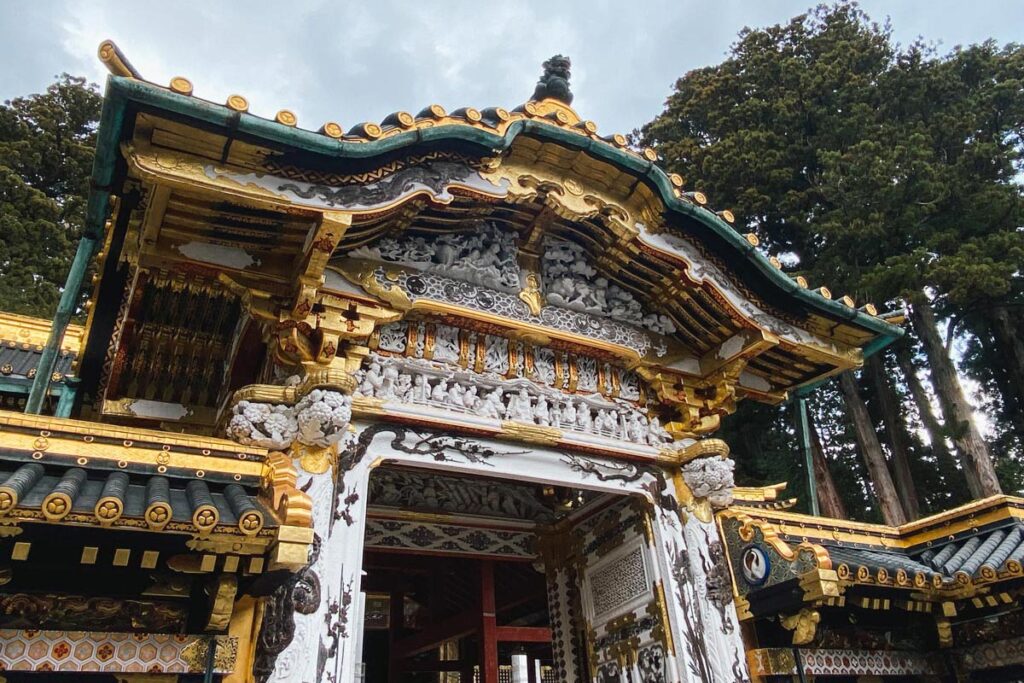


Other great day trips from Tokyo include Kamakura & Enoshima, Yokohama, Kawagoe, Mount Takao or visiting Disneyland/DisneySea.
Now, it’s time to head to our next home base in a different area of Japan: Kyoto. Being known as the cultural capital of Japan, Kyoto has a completely different feel from what we’ve seen so far. Filled with temples, shrines and the old Geisha districts, parts of Kyoto feel like stepping back in time.
Similar to our time in and around Tokyo, you can choose to spend a few days exploring Kyoto, and add one or two day trips (or an overnight trip) to your time here. As with the rest of this Japan itinerary, you can mix and match to fully make it your own. It’s also possible to spend more time in Kyoto and skip the day trips, of course!
To get to Kyoto from Tokyo, you can use the bullet train (Shinkansen). From Tokyo Station, it only takes around two hours and 15 minutes.
In previous years, the Japan Rail Pass would’ve been a great option for most travellers. However, since the price increase of this pass, it’s nowadays more cost-effective to buy individual tickets for the Shinkansen. You can either buy them on the day of your travel or pre-book them online.
Kyoto has so many great options for accommodation. As it’s the old capital of Japan, with large parts that are very well preserved, Kyoto is a great place to try staying in a ryokan. Luckily, many options combine modern and traditional, so you can have the best of both worlds.
We have a full guide breaking down the best areas and hotels in Kyoto, but for a quick overview, here are our top recommendations for first-time visitors:
As Kyoto and Osaka are two popular cities to visit and stay in, it’s also possible to pick Osaka as your home base for the next few nights. Kyoto isn’t far from Osaka, so you could pick a hotel in Osaka and take the train to Kyoto on day trips.
We’ve got a full guide comparing Kyoto and Osaka as your base in Japan, but generally, Osaka is a bit more modern, has better nightlife and is often cheaper. Kyoto, on the other hand, is a great place for staying in a traditional Japanese inn (ryokan) and has more sights to see, but accommodation here is often more expensive.
Even though Kyoto is smaller than Tokyo, it’s still a very large city with tons of things to see and do. Two full days definitely aren’t enough to see everything, so you can choose to spend a couple of extra days here instead of adding any of the day trips mentioned in the next sections.
However, you are able to see quite a few main highlights and get a great impression of what Kyoto has to offer in two days. We have a separate guide with a walking route that covers two days in Kyoto, but here are some of the main sights to check out:
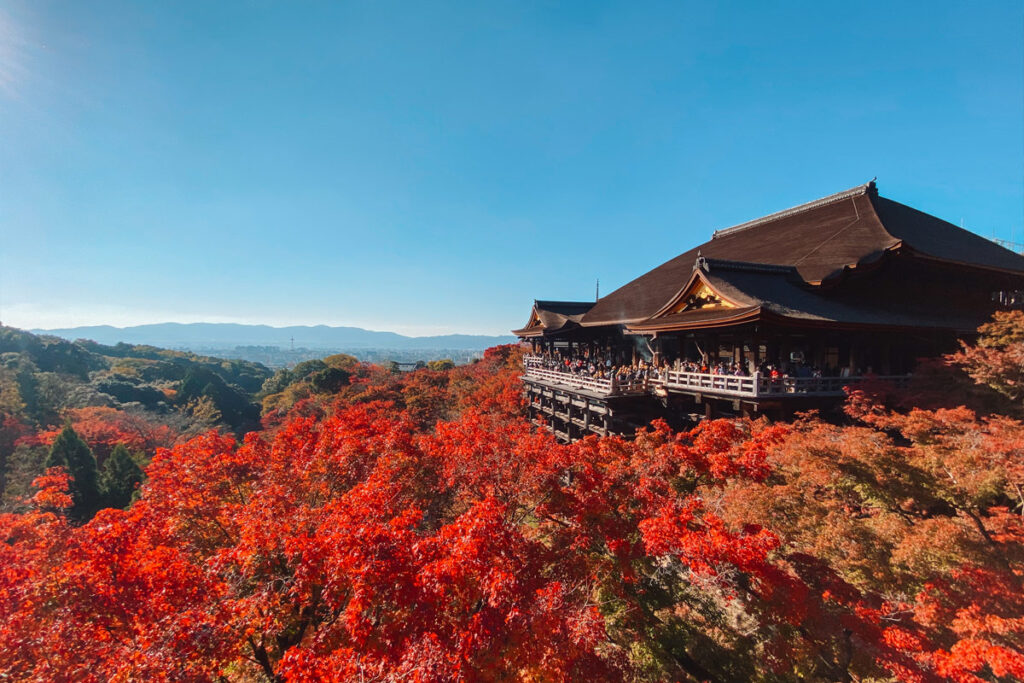
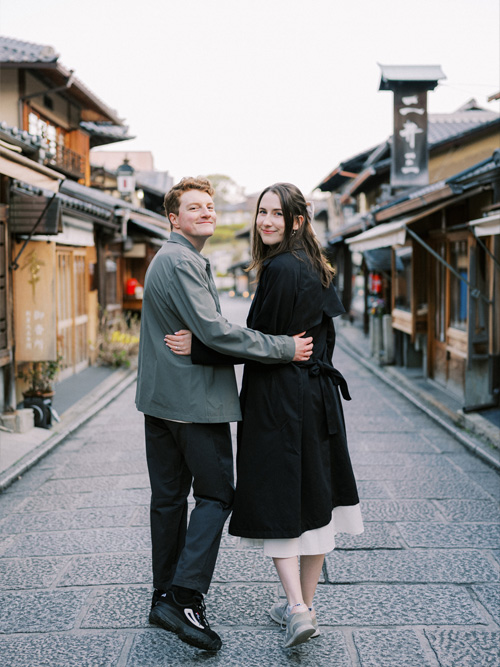
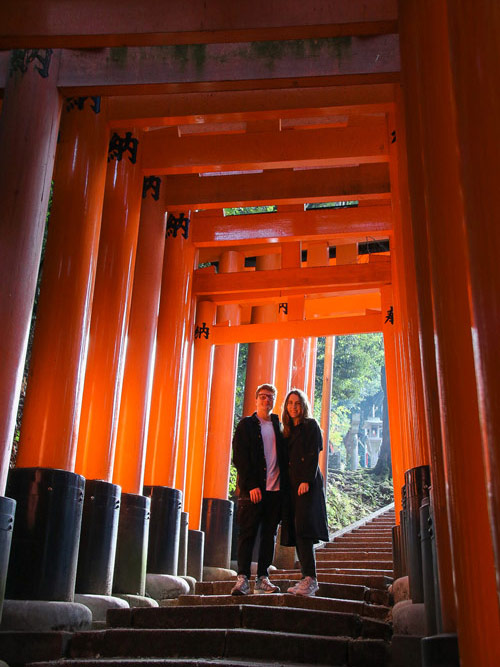
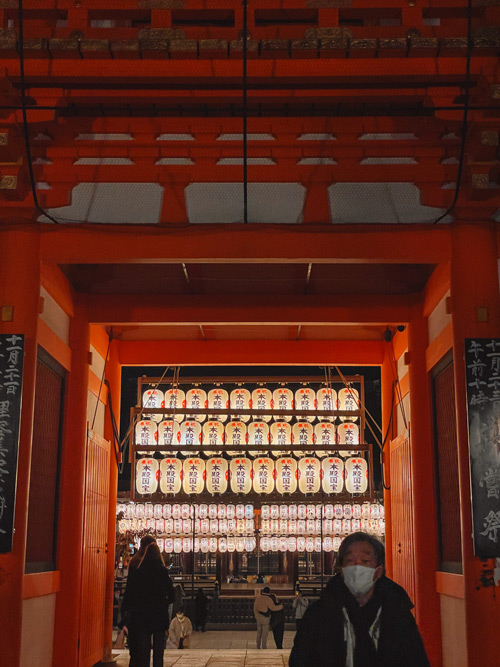
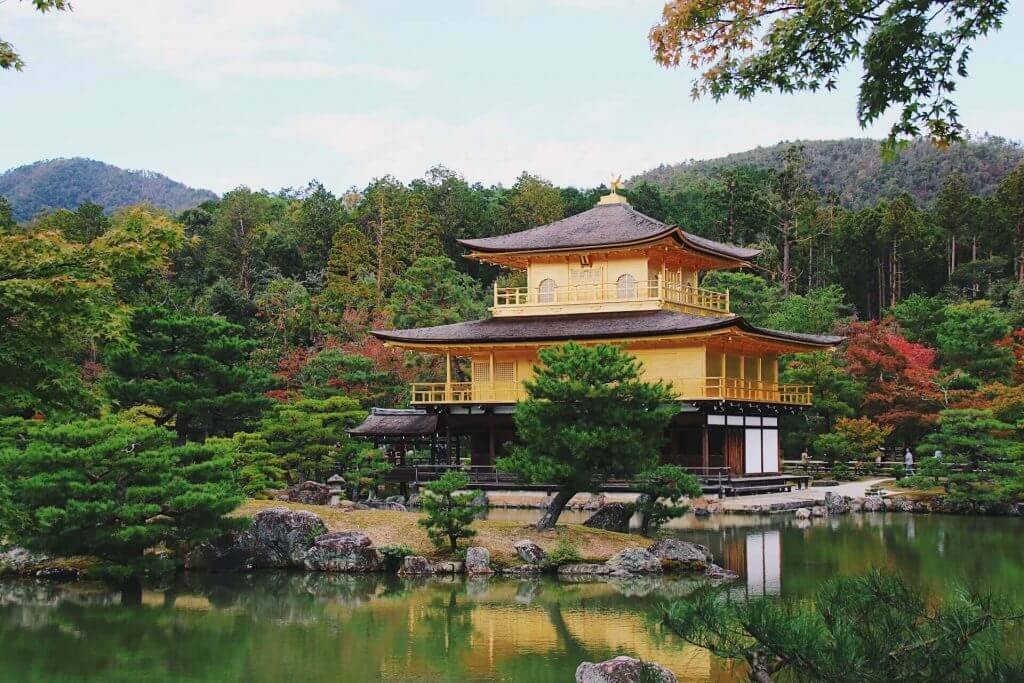
No Japan itinerary fits all, so I want to give some optional adjustments to this itinerary. That way, you can pick and choose the day trips from Kyoto that suit your interests most. Since the Kansai Region has so much to offer, taking a couple of day trips from Kyoto is a great idea to see more of Japan.
Some of my favourite day trips from Kyoto are Osaka, Nara, Kobe and Arima Onsen. I’ll share a rough day-trip itinerary for them below. In the section after that, I’ll also add some overnight stays from Kyoto that you could consider adding to this three-week Japan itinerary.
Osaka is another popular spot to visit near Kyoto. Since it’s only a short 15-minute Shinkansen ride, or a 30-40 minute local train ride, it’s also possible to pick Osaka as your base over Kyoto. Osaka is a bit more lively at night, it’s more modern, and accommodation is often cheaper here. We have a separate guide comparing Kyoto and Osaka as your base. Our guide on where to stay in Osaka can help, too.
Osaka makes for a great day trip as part of this itinerary, as you can see most of the main sights by following a loop around the city. Here are the spots we recommend you check out:
Our one day Osaka itinerary will show you the exact route to take and has more info on all the stops.

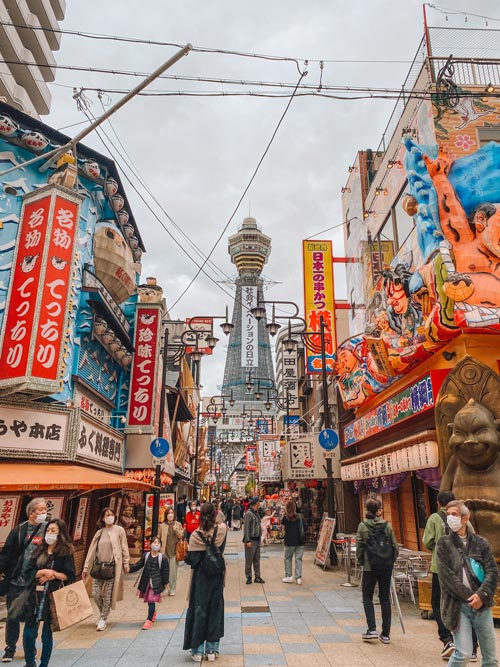
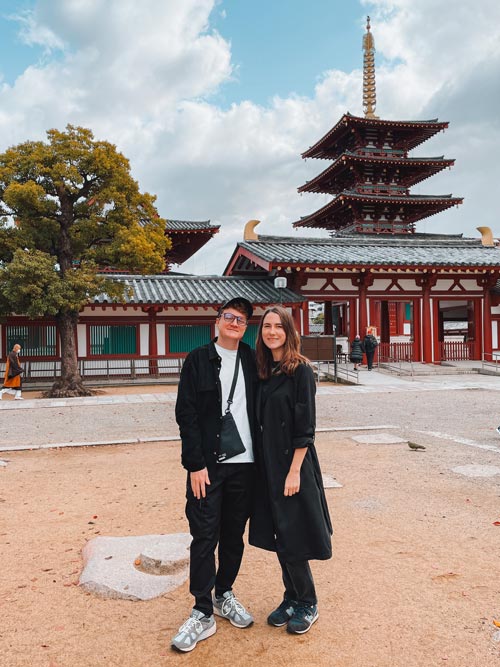
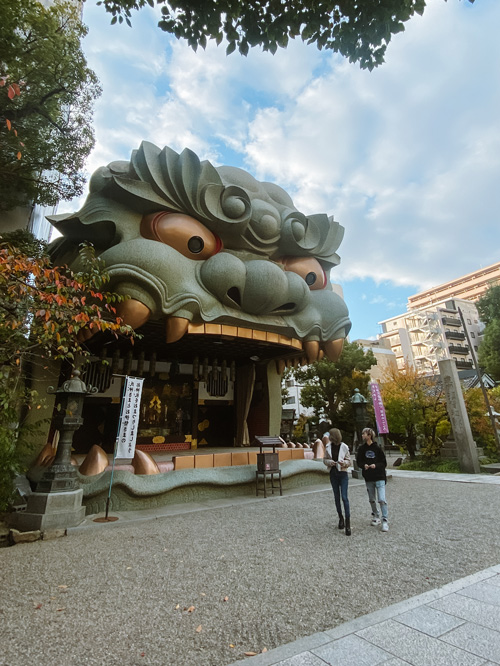
Less than an hour from Kyoto and Osaka lies Nara City. This traditional city was once the first permanent capital of Japan. Looking at the buildings, shrines and temples still here today, you can see how much history can still be enjoyed here.
Nara is most widely known for its free-roaming deer, but there are a lot of other places to see in Nara. If you’re planning on visiting for the day, make sure to check out the following places:
You can check out my full one day Nara itinerary for more information and a map with the walking route.

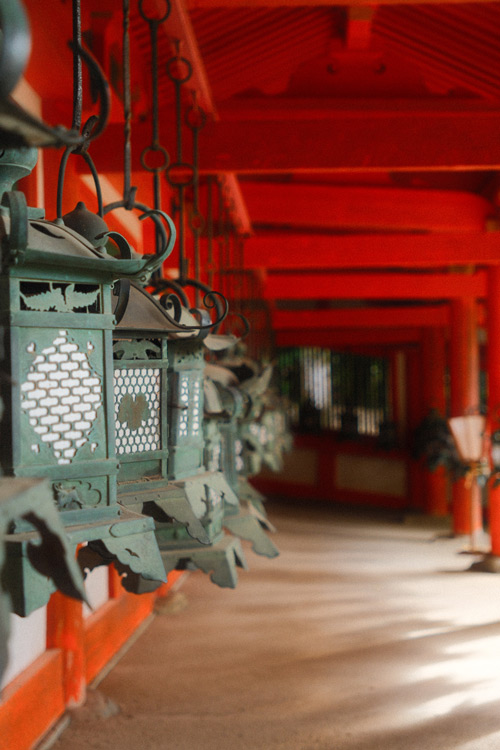

Another day trip option near Kyoto and Osaka is Kobe and the onsen town inside Kobe, Arima Onsen. Kobe itself has a fascinating history as it was the first port city to open its borders to the world after Japan was closed for 200+ years. It’s also the best place to try the famous Kobe beef.
If you’re looking to try onsen on a day trip, you can also head over to Arima Onsen, which is located north of Kobe City. This luxury hot spring resort has two types of water: Kinsen (gold) and Ginsen (silver), which can both be enjoyed as day guests in the main bathhouses.
When visiting Kobe and Arima Onsen, here are some spots to consider visiting:
For more information and free walking routes, you can check out our in-depth guides on how to spend a day in Kobe and Arima Onsen.

Kobe Beef at Mouriya Sannomiyaten
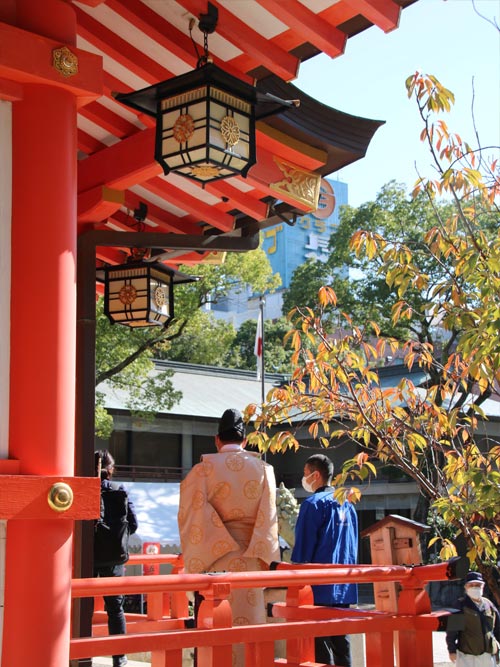
Ikuta Shrine in Kobe

Arimasansoh Goshobessho

Bath salts in Arima Onsen
Another option for the ninth and tenth day in this itinerary is adding an overnight stay in the Kansai region. There are some great spots nearby that offer unique accommodation, are just a bit too far for a one day trip or have way too much to see and do for one day.
Some of my favourite places to stay overnight near Kyoto or Osaka are Kinosaki Onsen, Koyasan or Nara Prefecture. You can choose one of these instead of taking two day trips from the list above. Below, I’ll share more information on these three options so you can decide what works best for you:
Onsen, or hot springs, are a big part of Japanese culture. So when you’re spending three weeks in Japan, adding an overnight stay to an authentic onsen town is a great idea. During my time in Japan, I’ve been to quite a few onsen towns, but Kinosaki Onsen remains my absolute favourite. From Kyoto, you can get here in around 2–3 hours.
Kinosaki Onsen is mainly known for its seven public bathhouses. In the evening, the streets fill with people dressed in yukata, hopping from one onsen to the next.
As the atmosphere at night is so magical, staying overnight makes more sense than only going for a day trip. Plus, it allows you to stay overnight in an authentic ryokan. When staying in any of the ryokans in Kinosaki Onsen, you’ll get free access to all seven public baths, so you can go try them yourself in the evening!
Here are the best things to do in Kinosaki Onsen:
For a more detailed route and guide, check out my 2-day Kinosaki Onsen itinerary. It includes more info on the sights, a walking route and how to book some of the experiences.
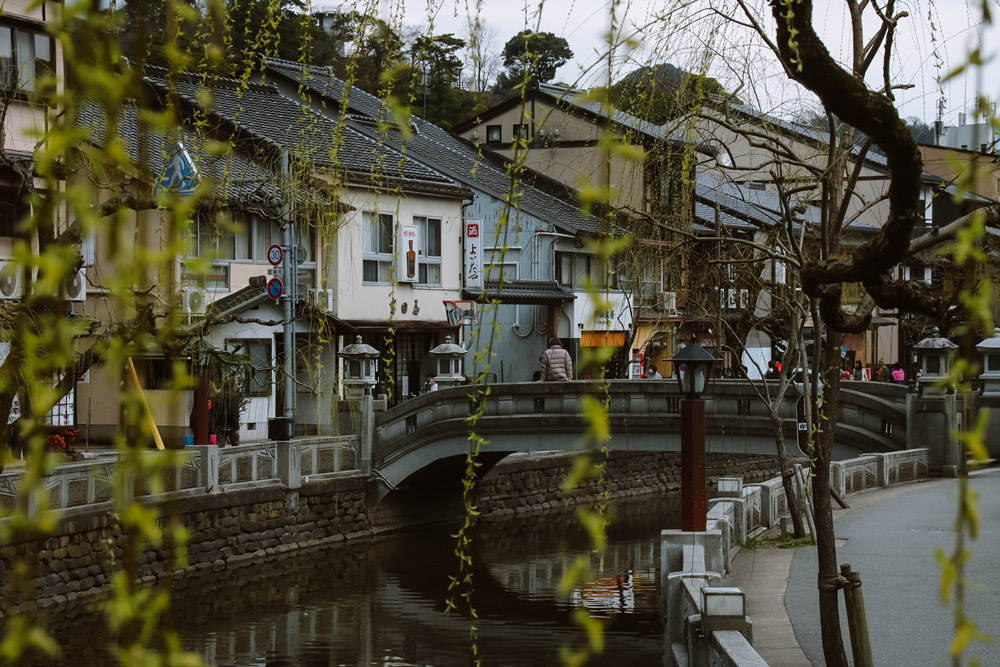


If you are interested in the spiritual side of Japan, staying overnight in Koyasan could be an amazing opportunity. Koyasan can be reached by public transport in around 90 minutes from Osaka, or around 2 hours from Kyoto.
Koyasan, or Mount Koya, is the centre of Shingon Buddhism and the final resting place of Kobo Daishi, the priest who brought Buddhism to Japan over 1,200 years ago.
This small mountain village is home to Japan’s largest cemetery (with over 200,000 gravestones, including Kobo Daishi’s mausoleum) and 117 active Buddhist temples. One of the most unique things to do in Koyasan is to stay overnight in one of these Buddhist temples, which is called Shukubo, or temple lodging.
Here are some of the best things to do when staying in Koyasan:
My full guide to Koyasan gives you more information on the sights and the best route to take when staying overnight. I also have a full review of my Shukubo experience at Rengejoin Temple, which is one of the most memorable experiences I’ve had in Japan.


Apart from visiting Nara on a day trip, staying overnight in Nara is something not many visitors do, but something I would highly recommend.
When you’re visiting for the day, you can see the deer park and surrounding areas, but Nara Prefecture has so much more to offer. When staying overnight, you can also see the deer park without the crowds before taking the train south towards some other amazing areas in Nara. Here are some of the best ones:

Omiwa Shrine

Horyu-ji Temple

Asuka
After Kyoto and its surroundings, we head further west towards Hiroshima. This will be our next base for a couple of days. Hiroshima is most commonly known for the devastating atomic bomb that was dropped here in 1945; however, the city has rebuilt itself into the welcoming city it is today.
From Kyoto, it takes around one and a half hours to get to Hiroshima on the Shinkansen. Again, you can buy tickets at the station on the day of your travel, or you can prebook them online (which is recommended if you travel with luggage or a large group).
For the next few days, you’ll be staying in Hiroshima. We have an in-depth guide on where to stay in Hiroshima (with the best areas and hotels), but here are our top picks:
When spending a day in Hiroshima, here is what we recommend visiting:
I’ve got a more in-depth guide to spending one day in Hiroshima, which includes additional information on all the sights and a walking route.
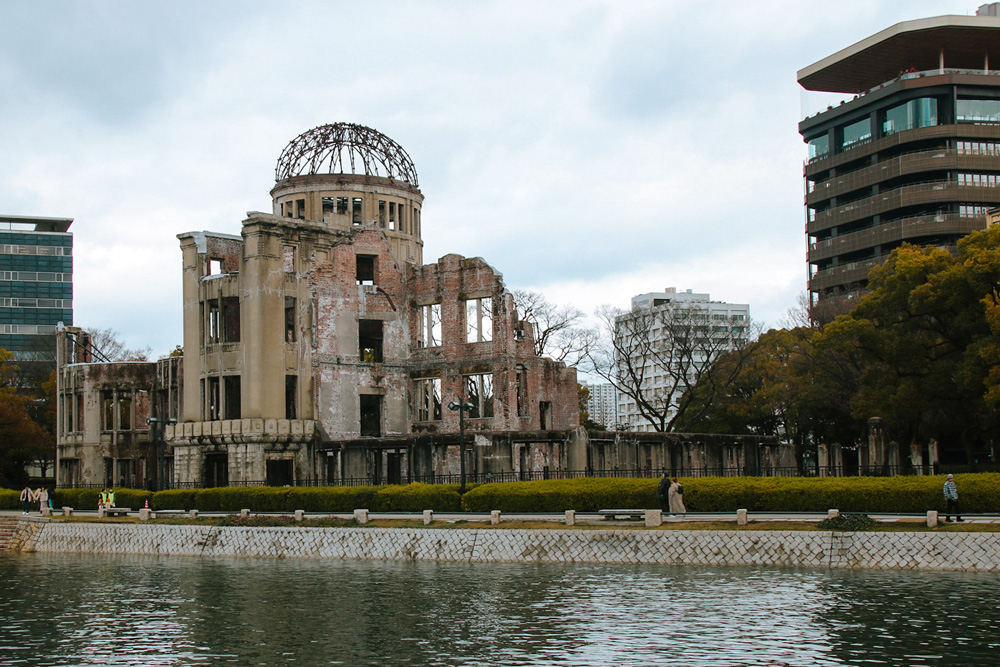

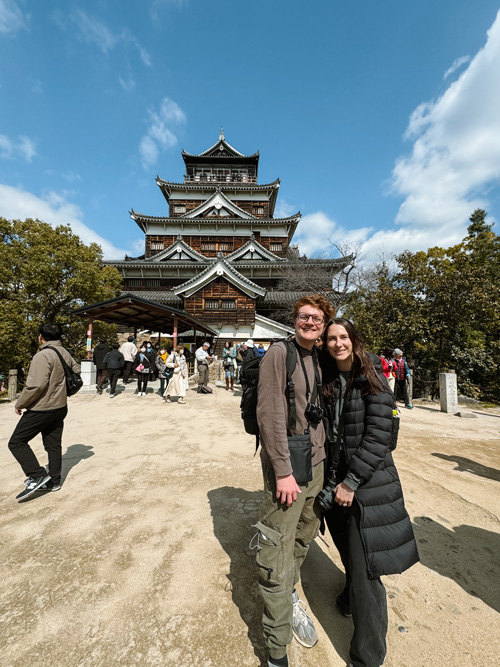

Known for the floating torii gate, one of the three most aesthetic views in Japan, Miyajima is a very popular day trip from Hiroshima. It only takes around 30 minutes to get to Miyajimaguchi Station on the JR Sanyo Line from Hiroshima Station. Alternatively, you can get the ferry from Motoyasu Pier in Hiroshima, but it’s more expensive.
When spending the day in Miyajima, make sure to check out the following spots:
Check out my one-day Miyajima itinerary or our Miyajima video guide for the full route and more information on all the sights.
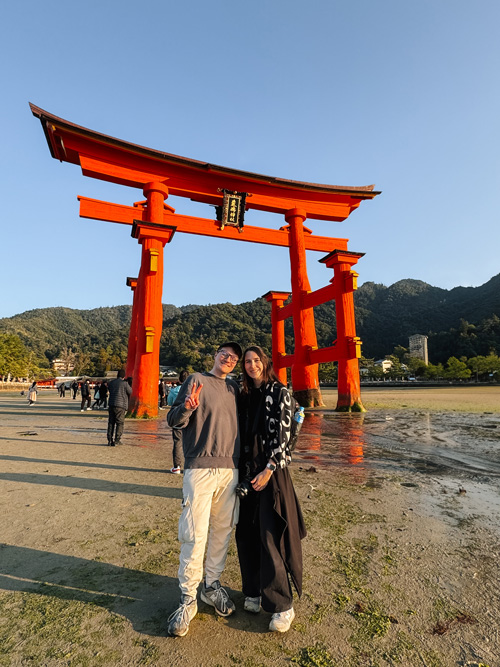
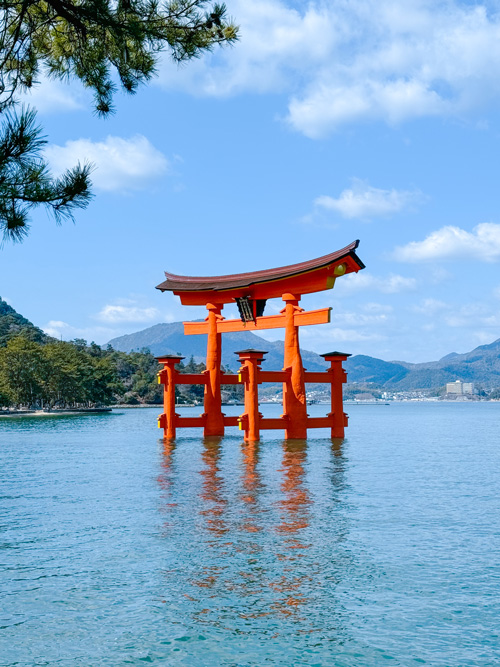
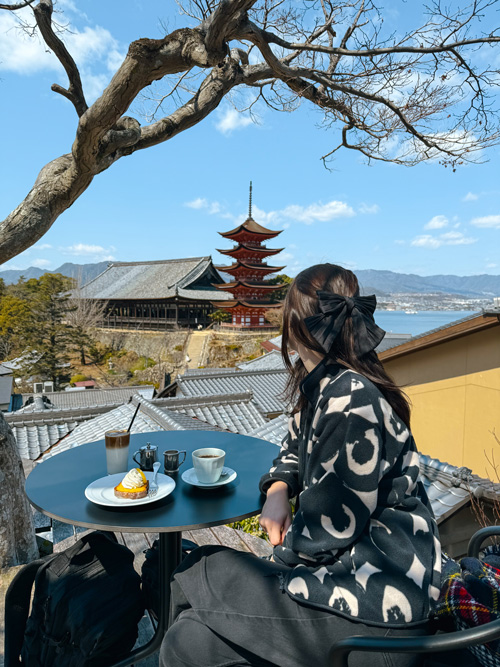

In this 3-week Japan itinerary, we’ll head to Kanazawa, Hida-Takayama and Matsumoto on the way back to Tokyo. If this doesn’t appeal to you, you could also keep moving West and visit Fukuoka, Nagasaki and other areas of Kyushu. Or, you could add some time off the beaten path in Shikoku.
After we finish our time in Hiroshima, it’s time for a long train journey to our next home base: Kanazawa. This is where you’ll book the next hotel for a few days – I’ve added Kanazawa hotel recommendations in the next section about Kanazawa. On the Shinkansen, the journey from Hiroshima to Kanazawa takes around 3.5–4 hours with a couple of changes.
However, if you do want to add an extra sightseeing spot to this day, the Shinkansen stops at Himeji along the way. Himeji Castle has a stunning white exterior and is said to be the most beautiful castle in Japan. While Himeji itself is a lovely city to visit, there isn’t a ton to see, making it a perfect half-day stopover on the way to Kanazawa.
Best of all, Himeji Station has lockers where you can securely store your luggage. You can also use luggage forwarding from Hiroshima to Kanazawa, so you don’t have to drag your suitcases along with you on this long journey.
Here are the main things you’d want to see when stopping at Himeji en route to Kanazawa:
Our full one-day Himeji itinerary explains everything in more detail.

If you’d rather skip Himeji, there are a few other lovely spots along the route towards Kanazawa for a half-day trip. Onomichi, Okayama and Kurashiki can be a good alternative for this day. It’s also possible to count day 14 as a travel day and rest up in the hotel, as the rest of the itinerary has been quite full on!

Following this itinerary, you should wake up in Kanazawa on your 15th day in Japan. After travelling up from Kyoto (with a possible stop at Himeji, Onomichi, Okayama or Kurashiki), you will have already arrived at your home base in Kanazawa.
Here are our recommendations on where to stay in Kanazawa:
Kanazawa pleasantly surprised me on my first visit, and I’ve been back a few times since! The historical atmosphere, the beautifully preserved geisha districts and the overall beauty of this city are incredible!
When spending a few days in Kanazawa, don’t forget to check out the following:


[IMG alt="geisha district kanazawa
"]https://thenavigatio.com/wp-content/uploads/2025/07/geisha-district-kanazawa.jpg[/IMG]
Today, we move our base from Kanazawa to Takayama for a few days. In between Kanazawa and Takayama lies another stop you can easily add to your itinerary: Shirakawago. We have a separate guide on where to stay in Takayama with our hotel recommendations.
Known for its beautiful thatched-roof farmhouses, Shirakawa-go is a popular day trip from either Kanazawa or Takayama. It’s perfectly possible to stop in between your journey from Kanazawa to Takayama.
If you can drive, I would recommend hiring a car for the day. You can pick it up in Kanazawa and drop it off in Takayama at the end of your day. We normally go with Toyota Rent-a-Car when hiring a car in Japan.
By driving, you won’t have to worry about your luggage. But most importantly, you can stop at two of the lesser-known (and less busy) towns that have similar houses: Ainokura and Suganuma.
Alternatively, you can use luggage transfer to send your luggage towards Takayama. You can then use the buses between Kanazawa and Takayama to travel to Shirakawa-go and onwards to Takayama.

If you want to skip Shirakawago but would still like to see some of the thatched roof houses, you can also visit Hida no Sato in Takayama. Multiple thatched-roof houses from Central Japan have been reconstructed here.


As we’re nearing the end of this itinerary, we take a few days to explore Takayama.
Takayama isn’t the largest town, so there are fewer accommodation options available. Here are our recommendations for where to stay in Takayama:
Here are some of the main sights in Takayama:

Depending on how much you want to see in Takayama, you could use one of the days for a short day trip to Hida-Furukawa. This small mountain village is only a short train ride from Takayama and has koi fish swimming in the canals. It’s a beautiful traditional town that most tourists completely miss!
Our final stop on this Japan itinerary is Matsumoto. As Takayama is hidden in the mountains, you’ll have to get a highway bus to get to Matsumoto. You can find the timetable and online tickets for it here.
Matsumoto isn’t as big a city, so hotel options are a bit more limited compared to other cities in this guide. However, I’ve stayed at Tabino Hotel Matsumoto multiple times and greatly enjoyed it. This modern hotel is located just a couple of minutes from the main station, with an on-site onsen and comfortable rooms.

Matsumoto Castle


Coffee Bigaku Abe


From Matsumoto, it’s very easy to head to Narai-Juku, one of the 69 post towns along the Nakasendo. If you have any more time in Japan, you can check out our 3-day Nakasendo itinerary. This route will take you along three days of hiking through central Japan.
And that concludes this 3-week Japan itinerary!
From Matsumoto, you can get a direct train back to Tokyo, which will take around two and a half hours. Depending on what time and what airport you’re flying home from, you may have to adjust the itinerary slightly.
When visiting Japan for the first time, three weeks is a perfect amount! It’s impossible to see all the amazing spots Japan has to offer in one trip, so roughly following this itinerary will give you a great first impression of this beautiful country.
Don’t be surprised if your first trip to Japan leaves you wanting to see more, though
 We have many other Japan itineraries ready for you to use for any second, third, or fourth trips!
We have many other Japan itineraries ready for you to use for any second, third, or fourth trips!
Happy travelling!
Planning your first trip to Japan can be pretty overwhelming! There is so much to see, and you may not quite know what to expect from a country like Japan. I felt the same way when I visited Japan for the very first time. Since then, I’ve been back so many times and now spend a few months in Japan every year.
Having travelled across a large chunk of the country, I put together this 3-week Japan itinerary for first-time visitors. I’ve included sights to see, routes to take, and where to stay, and you can copy it for free!
As part of this 3-week Japan itinerary, I’ll add different options you can use to customise this itinerary to fit your preferences. The red line of the itinerary follows the New Golden Route, but with the extra suggestions and options, you can make this Japan itinerary work for you without doing the same thing everybody else is doing.
Let’s take a look!
In This Travel Guide
- Three Weeks in Japan Overview
- 3 Week Japan Itinerary
- Tokyo (Day 1–3)
- Day Trips From Tokyo (Day 4–5)
- Kyoto (Day 6–8)
- (Optional) Day Trips From Kyoto or Osaka (Day 9–10)
- (Optional) Overnight Stay From Kyoto (Day 9–10)
- Hiroshima (Day 11–12)
- Miyajima (Day 13)
- Himeji (Day 14)
- Kanazawa (Day 15–16)
- Shirakawago (Day 17)
- Takayama (Day 18–19)
- Matsumoto (Day 20-21)
- Back to Tokyo (End of Itinerary)



Three Weeks in Japan Overview
Spending three weeks in Japan as a first-time visitor is perfect. It gives you enough time to see the main highlights recommended in most itineraries, along with extra time to see some places that many visitors have to skip due to time constraints.
During my first trip to Japan, I spent 2 weeks following the Golden Route. Looking back, I wish I’d added an extra week to see more of the country. As I now spend a few months in Japan every year, I’ve got a pretty good idea of what to recommend friends and family when they’re visiting for the first time. I hope that this guide will do the same for you!
I understand that no itinerary fits all, so I want to give you options in this guide. While the 3 weeks in Japan below roughly follow the New Golden Route, I’ve added multiple options and suggestions for different day trips, stop-overs or overnight stays. That way, you can really make this Japan itinerary your own.
To avoid wasting too much time travelling between cities or moving your luggage, it’s best to book a few “home bases”. From there, you can take day trips using public transport. In the next section, I outline the cities that serve as a good base for this itinerary (excluding any optional overnight stays, for which hotel recommendations are listed in their own section).
You can use the interactive Google Maps below to help you navigate the full itinerary.

Click here for the interactive Google maps







Where to Stay in Japan for Three Weeks
Moving hotels can take up a lot of time, and having to drag your suitcase from one place to the next isn’t ideal. So instead, it’s best to book a few “home bases” during your time in Japan. From there, you can easily explore the area or take day trips.
As briefly mentioned, this itinerary includes additional suggestions for day trips and overnight stays from some of these bases. I’ve added hotel recommendations in those sections, so you won’t find them in the block below.
| Days | City | Where To Stay |
|---|---|---|
| Day 1–6 | Tokyo | Where to stay in Tokyo |
| Day 6–10 | Kyoto or Osaka | Where to stay in Kyoto Where to stay in Osaka |
| Day 10–14 | Hiroshima | Where to stay in Hiroshima |
| Day 14–16 | Kanazawa | Where to stay in Kanazawa |
| Day 16–19 | Takayama | Where to stay in Takayama |
| Day 19–21 | Matsumoto | Where to stay in Matsumoto |
| End of itinerary | Tokyo | N/A |
3 Week Japan Itinerary
Here is my 3-week Japan itinerary for first-time visitors. Please note the suggestions for day-trips or other spots you can replace to make this Japan itinerary your own. You can also feel free to copy it exactly the way it is:
Tokyo (Day 1–3)
As most international flights arrive in one of Tokyo’s two airports (Haneda or Narita), I’ve started this Japan itinerary in Tokyo. Haneda Airport is a bit closer to Tokyo than Narita Airport, but it’s easy enough to get to the city from both of them on public transport. Taxis are also widely available, or you can hire a private airport transfer.
We have separate guides on how to get to Tokyo from Haneda Airport or from Narita Airport with info on the options, prices and times.
To make travelling inside cities easier, it’s also a good idea to pick up an IC card, like Suica or Pasmo, as soon as possible. These IC cards are pre-paid e-money cards that make it easy to travel on public transport, use vending machines and pay at certain shops. You can also download a digital version on your phone (along with some other handy Japan travel apps).
Where to Stay in Tokyo
The first few days of this itinerary are spent in and around Tokyo. It’s best to book your hotel in Tokyo for the first five nights.
I have a more in-depth guide on where to stay in Tokyo, which includes breakdowns of other areas, recommendations for different types of travellers and a host of other hotels I enjoyed staying in. For first-time visitors, I recommend the following hotels:
| Best For… | Hotel | Book Now |
| First-time visitors | Park Hotel Tokyo | Check Availability |
| Lively atmosphere | Hotel Sunroute Asakusa | Check Availability |
| Lively atmopshere | Candeo Hotels Roppongi | Check Availability |

Park Hotel Tokyo
Things to do in Tokyo
Tokyo is one of the biggest cities in the world, so three days will definitely not be enough to see everything! But it’ll give you a great first impression. Ideally, you pick one or two areas per day to explore, to avoid wasting too much time on public transport.
You can start by checking out my in-depth 6-day Tokyo itinerary. From the list, you can choose three of the days that speak to you most. Alternatively, you can check some of my highlighted suggestions below and put together your own itinerary:
- Visit Meiji Shrine: This is one of the main shrines in Tokyo, located in a large park near Harajuku. To get to the inner shrine, you’ll walk through a forest of over 100,000 trees (in the middle of Tokyo!). On the way, you’ll also pass a wall of 200+ traditional sake barrels.
- Walk across Shibuya Crossing: Named the busiest crossing in the world, Shibuya Crossing is a popular bucket list item in Japan. If you want a good view of the crossing, visit L’Occitane Cafe, Cé La Vi or the newly renovated Starbucks for a drink.
- Explore Senso-ji Temple: Dating back to 645, Senso-ji Temple is the oldest temple in Tokyo. Located in Asakusa, there is a lot to see and do in this area. The temple grounds themselves have multiple smaller shrines, including a beautiful pagoda and lovely Japanese gardens. You can try Japanese fortune telling, o-mikuji, or shop on Nakamise Street leading up to the temple.
- Enjoy Tokyo from above at Shibuya Sky: Shibuya Sky is a 360-degree open-air observation deck not far from Shibuya Crossing. Try to go around 30 minutes before sunset for the best views. As it’s become quite a popular spot, make sure you book tickets in advance. You can even see Mount Fuji from here on a clear day!
- Shop for kitchenware in Kappabashi: Between Asakusa and Ueno, you can find a street filled with the best shops for anything kitchen-related. From bowls and cups to chopsticks, pans and high-quality Japanese knives, you can find them in Kappabashi. As Japanese knives are known for their amazing quality, it’s a great souvenir to bring home if you like cooking.
- Explore Akihabara “Electric Town“: If you like video games, anime and other Japanese pop culture, a quick visit to Akihabara is a must. Even though the prices have gone up in recent years, it’s still a great spot to find retro video games, anime figures and more. It’s great fun, even if you’re just window shopping. You can also play in one of the many arcades here.
- Visit one of Roppongi’s museums/art galleries: Roppongi has some of the best museums and galleries in the city, particularly the famous Roppongi Art Triangle: Mori Art Museum, the National Art Gallery and the Suntory Museum of Art. The Mori Art Museum is my personal favourite, as it also offers one of the best views of Tokyo Tower.
- Get food and drinks in Shibuya Centre Gai: If you’re looking for things to do in Tokyo at night, visiting Shibuya Centre Gai is a must. This atmospheric and narrow street is a popular place to eat, shop and drink. Grab a drink and some food at one of the many izakayas.

Tokyo Tower

Kappabashi

Senso-ji Temple

Akihabara at night
Day Trips From Tokyo (Day 4–5)
While you still have a hotel in Tokyo, you can use the next few days to take some day trips from Tokyo. As there are quite a few great day trip destinations from Tokyo, you can choose the ones that fit your interests best.
Below, I’ve listed some of my favourite day trips with information on how to get there and what to do. When spending three weeks in Japan, you’ve got time for two of them (or spend more time in Tokyo!) before heading to the next city on this itinerary.
Mount Fuji
Mount Fuji is undoubtedly one of the most famous spots to visit in Japan. Visiting the area around Mount Fuji to see the famous volcano in all its glory can be a great idea for your trip to Japan. Kawaguchiko is a popular place to see Mount Fuji for its striking views and relatively easy access from Tokyo via public transport.
One thing to keep in mind when planning a day trip to Mount Fuji during your three weeks in Japan is that it likes to hide in the clouds. Trying to pick the perfect day to visit can be tricky, especially when it’s hard to predict the visibility of Mount Fuji.
You’ve got the best chance of seeing Mount Fuji during winter (December – February) and in the morning/evening. If seeing it is an absolute must for you, you could also decide to stay overnight around Mount Fuji. You can check this website, which predicts visibility, but it only shows it for a few days.
One way to increase your chances of seeing Mount Fuji is to keep your days in and around Tokyo flexible. Once you get to Tokyo, you could check the weather forecast and pick a day to visit the Mount Fuji area. If that’s not possible, you can always risk it.
To get to Kawaguchiko from Tokyo, you can use the following travel routes:
- Highway bus: The easiest way to get to Kawaguchiko from Tokyo is by using the highway bus. From Shinjuku, it costs ¥2,200 per person one way (¥1,100 for children) and takes you to Kawaguchiko in around 1 hour and 45 minutes. You can book tickets here.
- Fuji Excursion Train: You can get this express train from Shinjuku directly to Kawaguchiko in just under two hours. However, tickets are quite expensive (¥4,130 per person one way, ¥2,060 for children). As there are only a couple of trains per day, it’s best to book ahead. The JR Pass is valid for part of this line, until Otsuki, so JR Pass users will have to purchase an additional ticket from Otsuki to Kawaguchiko.
- Local Trains: Taking the local train towards Ōtsuki is also an option. It’s much cheaper compared to the express train, but it’ll take roughly 2–2.5 hours.
- Car: If you’re comfortable driving in Japan, hiring a car to drive to the Fuji Five Lakes area can be a great idea. It can work out more cost-effectively if you’re travelling with a group and split the cost. On top of that, you’ll have the freedom to visit areas that aren’t as accessible by public transport, making them a lot quieter.
- Day Tour/Private Driver: To avoid any stress, you can also opt for a private driver or book onto a day tour to Mount Fuji. This way, you don’t have to worry about how to get there or where the best spots are, as this will be taken care of.
We have a full guide on how to take a day trip to Mount Fuji from Tokyo with more information.


Hakone
With views of Mount Fuji, hot springs, beautiful shrines and lush nature, Hakone is a popular day trip from Tokyo. You can get here in 1–1.5 hours on public transport. It has a special place in my heart, as it’s also the spot where my husband proposed to me.
Because Hakone has some beautiful traditional ryokans and hot springs, staying overnight is something you can consider. It’ll add a lot to your trip, but I understand that with limited time in Japan, you have to make choices. Either way, you can easily follow the Hakone Loop during a day trip and see the highlights of this lovely onsen town.
Here are the best things to do in Hakone when visiting for the day:
- Visit Hakone Shrine: If you’ve seen pictures of Hakone, you probably will have seen the stunning torii gate of Hakone looking out over Lake Ashi. There is usually a queue of people waiting for a photo, but it does make for a lovely sight.
- Take the Pirate Ship Across Lake Ashi: To cross Lake Ashi, three Pirate-themed ships take visitors across. If you visit on a clear day, you should get some beautiful views of Mount Fuji from the ship.
- Explore Owakudani (Boiling Valley): As part of the Hakone Loop, you can take the ropeway up the mountain to visit Owakudani (the boiling valley). From Hakone, you can take a gondola up the mountain near the town. The volcano erupted 3,000 years ago, but the impact is still very much noticeable.
- Eat a Kuro-Tamago (Black Egg): When visiting Owakundani, you can eat one of the famous black eggs. These regular chicken eggs get their black colour from being boiled in the volcanic water. According to a local legend, eating one will prolong your life by seven years. Worth a shot, in my opinion!
- Visit the Hakone Open Air Museum: There are quite a few different museums in Hakone, but if you only have time for one, I recommend checking out the Hakone Open Air Museum. It has a large outdoor area where you can enjoy sculptures in a modern Japanese garden. Inside, you can walk through the Picasso Pavilion too.
To save time and money, you should consider purchasing the Hakone Free Pass. This discount pass gives you a return ticket from Shinjuku to Hakone plus free travel inside the Hakone area (including the Pirate Ship and Ropeway). You can check out the full one day Hakone itinerary in our separate guide.
If you’d like to stay overnight in Hakone, it’s possible to travel from Hakone to Kyoto without having to make your way back to Tokyo first. To do so, make your way to Odawara Station from Hakone on the local train and then get the Shinkansen to Kyoto.



Nikko
Nikko is a little further from Tokyo, but it is the perfect place for nature lovers. You can get there by train from Tokyo in around 2–3 hours. This mountain town sits in dense forest alongside some of the most beautiful shrines. A bit further from the main area, you can also find a stunning lake with hikes that will take you past waterfalls.
Because it’s a bit further from Tokyo, you can choose to stay overnight in one of the many ryokans in Nikko, but that depends on what other day trip options you want during your time in Japan.
Nikko also has a travel pass, called the Nikko World Heritage Area Pass. It includes a return train journey from Tokyo and unlimited travel inside Nikko. Even if you’re visiting for a day, it can be worth getting.
Visiting Nikko for the day is possible, and you can check out the following spots when doing so:
- Walk by the Shinkyo Bridge: Your first stop in Nikko will be the Shinkyo Bridge. It dates back to 1636 and is classed as a World Heritage Site. A couple of decades ago, it underwent restoration so people could walk across it (for a small fee), but just looking at it from the side makes for a lovely view.
- Visit Rinnō-ji Temple: This temple was founded by the monk who brought Buddhism to Nikko around 1,200 years ago. Today, it’s still used as a training ground for Tendai monks. Inside, you can also find eight-meter-tall gold statues of the deities of Nikko.
- Visit Tōshōgū Shrine: The most famous sight in Nikko is Tōshōgū Shrine. It is dedicated to the former Shogun, Ieyasu Tokugawa, who is also enshrined here. These lavishly decorated buildings are incredible to look at. Inside the temple grounds, you can also enjoy the sights of a five-storied pagoda and 101 stone lanterns covered in moss. It’s a must-visit when in Nikko.
- Explore the Kanmangafuchi Abyss: When Mount Nantai erupted many, many years ago, it created a large valley in the Nikko area. Today, you can find 74 statues here. Legend says that the number of statues changes every time you try to count them, though…


Other great day trips from Tokyo include Kamakura & Enoshima, Yokohama, Kawagoe, Mount Takao or visiting Disneyland/DisneySea.
Kyoto (Day 6–8)
Now, it’s time to head to our next home base in a different area of Japan: Kyoto. Being known as the cultural capital of Japan, Kyoto has a completely different feel from what we’ve seen so far. Filled with temples, shrines and the old Geisha districts, parts of Kyoto feel like stepping back in time.
Similar to our time in and around Tokyo, you can choose to spend a few days exploring Kyoto, and add one or two day trips (or an overnight trip) to your time here. As with the rest of this Japan itinerary, you can mix and match to fully make it your own. It’s also possible to spend more time in Kyoto and skip the day trips, of course!
To get to Kyoto from Tokyo, you can use the bullet train (Shinkansen). From Tokyo Station, it only takes around two hours and 15 minutes.
In previous years, the Japan Rail Pass would’ve been a great option for most travellers. However, since the price increase of this pass, it’s nowadays more cost-effective to buy individual tickets for the Shinkansen. You can either buy them on the day of your travel or pre-book them online.
Where to Stay in Kyoto
Kyoto has so many great options for accommodation. As it’s the old capital of Japan, with large parts that are very well preserved, Kyoto is a great place to try staying in a ryokan. Luckily, many options combine modern and traditional, so you can have the best of both worlds.
We have a full guide breaking down the best areas and hotels in Kyoto, but for a quick overview, here are our top recommendations for first-time visitors:
| Best For… | Hotel | Book Now |
| First Time Visitors | Hotel Resol Kyoto Kawaramachi Sanjo | Check Availability |
| Mix of Modern & Traditional | Candeo Hotels Kyoto Karasuma Rokkaku | Check Availability |
| Traditional atmosphere (in old Geisha district) | Kyoto Granbell Hotel | Check Availability |
| (Extra) Unique Stay | Marufukuro (Former Nintendo Headquarters) | Check Availability |
As Kyoto and Osaka are two popular cities to visit and stay in, it’s also possible to pick Osaka as your home base for the next few nights. Kyoto isn’t far from Osaka, so you could pick a hotel in Osaka and take the train to Kyoto on day trips.
We’ve got a full guide comparing Kyoto and Osaka as your base in Japan, but generally, Osaka is a bit more modern, has better nightlife and is often cheaper. Kyoto, on the other hand, is a great place for staying in a traditional Japanese inn (ryokan) and has more sights to see, but accommodation here is often more expensive.
What to do in Kyoto
Even though Kyoto is smaller than Tokyo, it’s still a very large city with tons of things to see and do. Two full days definitely aren’t enough to see everything, so you can choose to spend a couple of extra days here instead of adding any of the day trips mentioned in the next sections.
However, you are able to see quite a few main highlights and get a great impression of what Kyoto has to offer in two days. We have a separate guide with a walking route that covers two days in Kyoto, but here are some of the main sights to check out:
- Visit Kyoto’s Geisha District: Higashiyama and Gion are Kyoto’s famous old Geisha districts (called Geiko in Kyoto). It’s a pretty touristy place, so be prepared for large crowds. It is still an incredible place to visit. The wooden houses are lined up along the streets, with some of Kyoto’s best temples and shrines scattered around the area. Kiyomizudera Temple is one of them, and should not be missed!
- See Fushimi Inari Taisha: The famous shrine with thousands of red torii gates is also located in Kyoto. You can hike up the mountain through the rows and rows of torii gates, which takes around 2-3 hours. The start of the hike is usually very busy, but the higher you go, the fewer people will be there. You can also choose to go very early to avoid the crowds, as the shrine is open 24/7.
- Wear a Kimono: Wearing Japan’s traditional clothing, the kimono, can be done in many places across Japan, but Kyoto is an obvious spot for it. For a few thousand yen, you can rent a kimono for a few hours. A professional dresser will help you put it on; it’s a very unique experience!
- See Kinkaku-ji Temple: The Golden Pavilion in Kyoto is one of the city’s 17 UNESCO World Heritage Sites. This beautiful temple is covered in gold on the outside, and has some lovely gardens to explore in the neighbourhood.
- Explore Arashiyama Bamboo Grove: Located in West Kyoto, the famous bamboo grove is one of the most photographed spots in the city. It’s beautiful to see, but prepare for crowds! There are some other bamboo groves in Kyoto that are less popular, including multiple around the Arashiyama area and the bamboo forest of Kodai-ji Temple in the Geisha district.





(Optional) Day Trips From Kyoto or Osaka (Day 9–10)
No Japan itinerary fits all, so I want to give some optional adjustments to this itinerary. That way, you can pick and choose the day trips from Kyoto that suit your interests most. Since the Kansai Region has so much to offer, taking a couple of day trips from Kyoto is a great idea to see more of Japan.
Some of my favourite day trips from Kyoto are Osaka, Nara, Kobe and Arima Onsen. I’ll share a rough day-trip itinerary for them below. In the section after that, I’ll also add some overnight stays from Kyoto that you could consider adding to this three-week Japan itinerary.
Osaka
Osaka is another popular spot to visit near Kyoto. Since it’s only a short 15-minute Shinkansen ride, or a 30-40 minute local train ride, it’s also possible to pick Osaka as your base over Kyoto. Osaka is a bit more lively at night, it’s more modern, and accommodation is often cheaper here. We have a separate guide comparing Kyoto and Osaka as your base. Our guide on where to stay in Osaka can help, too.
Osaka makes for a great day trip as part of this itinerary, as you can see most of the main sights by following a loop around the city. Here are the spots we recommend you check out:
- See Osaka Castle: While it’s not the original castle that once stood here, Osaka Castle is still beautiful to look at. Surrounding it, you can find some lovely gardens too. Inside the castle, you can find a museum that explains the role this castle played in unifying the country in the 16th century.
- Visit Shinsekai: The Shinsekai district in Osaka was developed during the National Industrial Revolution. There are countless restaurants and food stands here, making it a great spot for lunch or dinner. You can also see the Tsutenkaku Tower, which was modelled after Paris’ Eiffel Tower.
- Go to Namba Shrine: One of the most unique shrines we’ve come across in Japan, Namba Shrine in Osaka has a 12-meter-tall lion head as one of their main buildings. Legend says the lion swallows any evil spirits.
- Explore Dotonbori: This area of Osaka is the heart of the city’s nightlife. You can also find the famous Glico Man sign here, along with many street food stalls, restaurants, shops, arcades and more.
Our one day Osaka itinerary will show you the exact route to take and has more info on all the stops.




Nara
Less than an hour from Kyoto and Osaka lies Nara City. This traditional city was once the first permanent capital of Japan. Looking at the buildings, shrines and temples still here today, you can see how much history can still be enjoyed here.
Nara is most widely known for its free-roaming deer, but there are a lot of other places to see in Nara. If you’re planning on visiting for the day, make sure to check out the following places:
- Walk Through Nara Deer Park: One of the most famous spots in Nara is the Deer Park. Over 1,400 Sika deer live here and walk around freely. You may have seen them in videos online where they bow to visitors to score some crackers. They’re very cute, but remember they are wild animals, so be cautious around them!
- Visit Kasuga Taisha Shrine: This UNESCO World Heritage Site is one of the most beautiful places in Nara City. With over 2,000 stone lanterns and 1,000+ bronze lanterns, Kasuga Shrine is a must-visit. There is a small entrance fee to visit the inner shrine, but it’s 100% worth it.
- Have Udon at Mizuya Chaya: Inside the deer park, you can find a small restaurant with a thatched roof selling delicious udon. It’s a great spot to stop for lunch. It’s affordable and delicious, plus you’ll be able to enjoy the forest views while eating.
- Visit Todai-ji Temple: Another UNESCO World Heritage Site, Todai-ji Temple (Great Eastern Temple) was the world’s largest wooden structure until 1998. It’s completely made out of wood and is home to the largest Daibutsu-san, or Bronze Buddha Statue, in the world. You’ll have to pay for a ticket to go inside, but it’s worth seeing the Buddha up close.
- Explore Yoshikien & Isuien Gardens: There are two beautiful gardens in Nara, located next to each other. Isuien Garden is the more popular of the two, but there is a steep entrance fee. Yoshikien Garden, on the other hand, can be visited for free by foreign visitors. Both gardens are beautiful, so it’s worth stopping by at least one of them during your time in Nara.
You can check out my full one day Nara itinerary for more information and a map with the walking route.



Kobe & Arima Onsen
Another day trip option near Kyoto and Osaka is Kobe and the onsen town inside Kobe, Arima Onsen. Kobe itself has a fascinating history as it was the first port city to open its borders to the world after Japan was closed for 200+ years. It’s also the best place to try the famous Kobe beef.
If you’re looking to try onsen on a day trip, you can also head over to Arima Onsen, which is located north of Kobe City. This luxury hot spring resort has two types of water: Kinsen (gold) and Ginsen (silver), which can both be enjoyed as day guests in the main bathhouses.
When visiting Kobe and Arima Onsen, here are some spots to consider visiting:
- Visit Kobe Nunobiki Herb Gardens: You can take the 10-minute ropeway ride up towards the famous herb gardens. The ticket for the ropeway also includes a ticket to the herb gardens, so I recommend getting the ropeway up and walking down through the gardens. The gardens are divided into 12 areas with more than 75,000 plants.
- Grab Lunch in Nankinmachi, Kobe’s Chinatown: Japan has three Chinatowns, located in Yokohama, Nagasaki and Kobe. You can find lots of tasty street food here, and it’s a lovely area to stroll around.
- Try Kobe Beef: What better place to try the famous Kobe beef than Kobe itself? This tender Japanese Wagyu is known to be the most expensive (and delicious) beef in the world. There are a lot of places in Kobe where you can try it. If you want it a bit cheaper, you can opt for a lunch set. But always do your research, as there are some restaurants selling beef that’s not classed as Kobe beef. I tried it at Mouriya Sannomiyaten, which is an amazing restaurant!
- Wander Through Yumotozaka Shopping Street: Arima Onsen has a charming shopping street with Edo-style wooden buildings housing shops, cafes and restaurants. You can even hear some of the geiko practising their shamisen sometimes.
- Try Arima Onsen’s Golden Water: There are two public bathhouses in Arima Onsen, both accept day guests, making it perfect for a day trip. Kin no Yu has golden water, Gin no Yu has silver water. You can get a combination ticket to try both! Alternatively, you can try one of the free footbaths around the town.
For more information and free walking routes, you can check out our in-depth guides on how to spend a day in Kobe and Arima Onsen.

Kobe Beef at Mouriya Sannomiyaten

Ikuta Shrine in Kobe

Arimasansoh Goshobessho

Bath salts in Arima Onsen
(Optional) Overnight Stay From Kyoto (Day 9–10)
Another option for the ninth and tenth day in this itinerary is adding an overnight stay in the Kansai region. There are some great spots nearby that offer unique accommodation, are just a bit too far for a one day trip or have way too much to see and do for one day.
Some of my favourite places to stay overnight near Kyoto or Osaka are Kinosaki Onsen, Koyasan or Nara Prefecture. You can choose one of these instead of taking two day trips from the list above. Below, I’ll share more information on these three options so you can decide what works best for you:
Kinosaki Onsen
Onsen, or hot springs, are a big part of Japanese culture. So when you’re spending three weeks in Japan, adding an overnight stay to an authentic onsen town is a great idea. During my time in Japan, I’ve been to quite a few onsen towns, but Kinosaki Onsen remains my absolute favourite. From Kyoto, you can get here in around 2–3 hours.
Kinosaki Onsen is mainly known for its seven public bathhouses. In the evening, the streets fill with people dressed in yukata, hopping from one onsen to the next.
As the atmosphere at night is so magical, staying overnight makes more sense than only going for a day trip. Plus, it allows you to stay overnight in an authentic ryokan. When staying in any of the ryokans in Kinosaki Onsen, you’ll get free access to all seven public baths, so you can go try them yourself in the evening!
Here are the best things to do in Kinosaki Onsen:
- Go Onsen Hopping: As mentioned above, Kinosaki Onsen has seven public onsen. If you stay overnight in any of the ryokans in town, you’ll receive an onsen pass, which gives you free access to all seven public baths. Put on your yukata and geta and wander the streets of Kinosaki Onsen, trying as many onsen as you can.
- Try Tajima Beef: Kinosaki Onsen is located in Hyogo Prefecture, which is famous for its Kobe Beef (you may have heard of it before, as it’s known to be the most delicious meat in the world). Kobe Beef comes from pure-bred Tajima cattle. While not all Tajima cows can be classed as Kobe Beef, you can still expect excellent quality.
- Eat Matsuba (Snow) Crab: Another delicacy that brings people to Kinosaki Onsen is Matsuba Crab, or Snow Crab. Between November and March, these crabs can be caught near Kinosaki Onsen, making them as fresh as they can be. If you’re having a Keiseki dinner in your ryokan and you’re visiting during the winter months, there’s a big chance you get to try this delicious crab.
- Use the Free Footbaths: Hot spring water is a renewable resource, and Kinosaki Onsen uses this as much as possible. Across the town, you can find multiple footbaths you can use for free. Make sure you bring a small towel to dry your feet afterwards!
- Hike up Mount Dashi to Visit Onsenji Temple: The hot spring water in Kinosaki Onsen was believed to be healing. And to be allowed into the waters, visitors would have to walk a short pilgrimage halfway up Mount Daishi to visit Onsenji Temple. Those who made it to the temple were given a special ladle, which acted as their ticket to the onsen. Nowadays, it’s no longer required to visit the temple, but it is beautiful, so definitely worth the walk.
- Join a Zen Meditation at Gokurakuji Temple: The Kinosaki Onsen Tourism Board offers some very unique experiences in the town, including a traditional straw crafting workshop and a Zen meditation with the head of Gokurakuji Temple. The temple itself is beautiful, with a well-kept Zen garden at the front. The Zen meditation was incredible, and we got to chat with the head monk for a bit afterwards. It was such a special experience, and one I’d highly recommend booking.
- Stay Overnight in an Authentic Ryokan: Staying in Kinosaki Onsen for one night during your three weeks in Japan gives you the opportunity to sleep in a traditional Japanese inn, or ryokan. There are 70+ ryokan in Kinosaki Onsen, so more than enough choice. We stayed in Nishimuraya Hotel Shogetsutei, which was amazing!
For a more detailed route and guide, check out my 2-day Kinosaki Onsen itinerary. It includes more info on the sights, a walking route and how to book some of the experiences.



Koyasan (Mount Koya)
If you are interested in the spiritual side of Japan, staying overnight in Koyasan could be an amazing opportunity. Koyasan can be reached by public transport in around 90 minutes from Osaka, or around 2 hours from Kyoto.
Koyasan, or Mount Koya, is the centre of Shingon Buddhism and the final resting place of Kobo Daishi, the priest who brought Buddhism to Japan over 1,200 years ago.
This small mountain village is home to Japan’s largest cemetery (with over 200,000 gravestones, including Kobo Daishi’s mausoleum) and 117 active Buddhist temples. One of the most unique things to do in Koyasan is to stay overnight in one of these Buddhist temples, which is called Shukubo, or temple lodging.
Here are some of the best things to do when staying in Koyasan:
- Stay Overnight in a Buddhist Temple: One of the main reasons to stay overnight in Koyasan is to experience sleeping in an active Buddhist temple. Not only do you get to stay the night here, but you’ll join the monks in some of their daily rituals. During my time in Koyasan, I stayed at Rengejoin Temple. As part of the stay, I got to join their Ajikan meditation session in the afternoon and the morning Sutra reading in the morning. Dinner and breakfast were also included, which were authentic Buddhist Shojin Ryori meals. It’s an experience I’ll never forget!
- Visit Japan’s Largest Cemetery, Okunoin: If you’re only seeing one sight in Koyasan, it has to be Okunoin. This is the largest cemetery in Japan, located in a cedar forest on Mount Koya. There are over 200,000 gravestones in this cemetery, alongside Kobo Daishi’s mausoleum. When staying overnight, make sure to book a night tour of the cemetery, where one of Koyasan’s monks guides you through the cemetery and teaches you everything you need to know about this sacred place.
- Watch the Shoujingu Ceremony: In the morning, head back to Okunoin to watch a special ceremony at the Gobyo-bashi bridge (at 6 AM or 10:30 AM). As it’s believed that Kobo Daishi entered his eternal meditation in his mausoleum, the monks have been offering him food twice a day. They’ve been doing this for over 1,000 years, so it’s quite special to see them carry it across the bridge.
- Try a Traditional Shojin Ryori Meal: The traditional cuisine for the monks here is called Shojin Ryori. These dishes are fully vegan and made from locally sourced vegetables and mountain plants. Ingredients with overwhelming flavours, like garlic, cannot be used. The meals are put together with a focus on five flavours (sweet, sour, salty, bitter, and umami), five cooking methods (raw, baked, fried, boiled and steamed) and five colours (red, blue, black, yellow, and white). Every dish is put together beautifully.
- Visit Kongobuji Temple: There are quite a few temples to visit in Koyasan, but Kongobuji is definitely the one to check out if you’re short on time. This is the head temple on Mount Koya and home to Japan’s largest rock garden.
My full guide to Koyasan gives you more information on the sights and the best route to take when staying overnight. I also have a full review of my Shukubo experience at Rengejoin Temple, which is one of the most memorable experiences I’ve had in Japan.


Nara Prefecture
Apart from visiting Nara on a day trip, staying overnight in Nara is something not many visitors do, but something I would highly recommend.
When you’re visiting for the day, you can see the deer park and surrounding areas, but Nara Prefecture has so much more to offer. When staying overnight, you can also see the deer park without the crowds before taking the train south towards some other amazing areas in Nara. Here are some of the best ones:
- Horyu-ji Temple: Only 30 minutes from Nara Station, this is one of the oldest temples in Japan (dating back to 607). The main hall and pagoda are the oldest surviving wooden structures in the world.
- Omiwa Shrine: The exact age of this shrine isn’t known, but Omiwa Shrine is considered to be one of the oldest in Japan. It sits in a lush forest, and there are a lot of local restaurants and shops between the shrine and the station.
- Asuka: Around one hour from Nara Station, Asuka makes for a perfect day trip to the Japanese countryside. This is the official first capital of Japan, where you can rent a bike and cycle through the very well-preserved town surrounded by rice fields. Around Asuka, you can find countless ancient tombs, which have played a huge role in the preservation of Japanese culture.
- Mount Yoshino: Mount Yoshino is the place to visit if you’re looking for the best spot to see cherry blossoms in spring. Around one hour from Nara Station, this area has over 30,000 cherry trees. Autumn is another great time to visit, as the leaves will have turned a beautiful red colour.

Omiwa Shrine

Horyu-ji Temple

Asuka
Hiroshima (Day 11–12)
After Kyoto and its surroundings, we head further west towards Hiroshima. This will be our next base for a couple of days. Hiroshima is most commonly known for the devastating atomic bomb that was dropped here in 1945; however, the city has rebuilt itself into the welcoming city it is today.
From Kyoto, it takes around one and a half hours to get to Hiroshima on the Shinkansen. Again, you can buy tickets at the station on the day of your travel, or you can prebook them online (which is recommended if you travel with luggage or a large group).
Where to Stay in Hiroshima
For the next few days, you’ll be staying in Hiroshima. We have an in-depth guide on where to stay in Hiroshima (with the best areas and hotels), but here are our top picks:
| Best For… | Hotel | Book Now |
|---|---|---|
| Best Hotel | Rihga Royal Hotel Hiroshima | Check Availability |
| Best Ryokan | Hiroshima no Yado Aioi | Check Availability |
| Best Apartment Stay | Nekoyacho | Check Availability |
| Best Budget Stay | Hiroshima City Bunka Koryu Kaikan | Check Availability |
What to do in Hiroshima
When spending a day in Hiroshima, here is what we recommend visiting:
- See Hiroshima Castle & Gokoku Shrine: Hiroshima Castle, also known as Carp Castle, makes for a great first stop during your time in Hiroshima. Near it, you can also stop by Gokuko Shrine, welcoming you with the large stone torii gate just outside the shrine.
- Stop by the Atomic Bomb Dome: Hiroshima is most known for the devastating bombing that happened during WWII. While most of the city was wiped away, this structure somehow survived. The people of Hiroshima have rebuilt the city, but kept this dome as a symbol of hope.
- Visit the Hiroshima Atomic Bomb Hypocentre Monument: This monument is a bit tricky to find as it sits between some tall buildings, so many visitors skip it (or don’t know it exists). Around 600 meters above this spot is where the atomic bomb exploded. It’s chilling to stand there, but since it’s close to the Atomic Bomb Dome, it’s worth stopping by.
- Wander Through Hiroshima Peace Memorial Park: You can find many monuments scattered across the park to commemorate the lives that were lost in the bombing, including the Children’s Peace Monument. Also, make sure you stop by the Rest House. Inside, you can visit a free exhibition of the memoirs of the sole survivor who used to work in this very building during the bombing.
- Visit the Hiroshima Peace Memorial Museum: Visiting the Hiroshima Peace Memorial Museum is an emotional experience, but a very important one. It’s a place to remember the victims of the atomic bombing of 1945 and learn more about what happened. I recommend doing this near the end of your visit, as it’s quite heavy.
- Eat Hiroshima-Style Okonomiyaki: Okonomiyaki is a popular dish in Osaka, but Hiroshima has its own style you should try before leaving! These savoury pancakes are made with cabbage, egg, flour and other ingredients of choice. Hiroshima Okonomi Monogatari is a great spot to try them, but you can find okonomiyaki restaurants all across the city.
I’ve got a more in-depth guide to spending one day in Hiroshima, which includes additional information on all the sights and a walking route.




Miyajima (Day 13)
Known for the floating torii gate, one of the three most aesthetic views in Japan, Miyajima is a very popular day trip from Hiroshima. It only takes around 30 minutes to get to Miyajimaguchi Station on the JR Sanyo Line from Hiroshima Station. Alternatively, you can get the ferry from Motoyasu Pier in Hiroshima, but it’s more expensive.
When spending the day in Miyajima, make sure to check out the following spots:
- See the Grand Torii Gate of Itsukushima Shrine: The most popular landmark to see in Miyajima is the Grand Torii Gate of Itsukushima Shrine. During high tide, it appears to be floating on the water, making for one of the three most beautiful views in Japan. It’s also worth visiting Itsukushima Shrine itself and the Treasure Hall.
- Visit Senjōkaku Pavilion: This large pavilion, looking out over the Seto Inland Sea, was commissioned by Toyotomi Hideyoshi in 1587. However, he died before they were able to finish it, leaving it without any walls. You can visit it for ¥100. Next to it, you can also find Miyajima’s Five-Storied Pagoda.
- Hike down Mount Misen: Miyajima’s sacred mountain has a hiking trail and a ropeway you can use. As you only have one day in Miyajima, I recommend taking the ropeway up and walking down, as it takes a lot less time. You can stop by the Eternal Flame of Reikado Hall, where you can see a fire lit by Kobo Daishi 1,200 years ago.
- Try a Momiji Manjū: One of Miyajima’s specialities includes these small maple-leaf-shaped pastries called Momiji Manjū. They come with lots of different flavours and are made fresh on the island.
- Eat grilled oysters or conger eel: Miyajima is surrounded by the sea, having access to the freshest seafood. Grilled oysters and conger eel are particularly popular.
Check out my one-day Miyajima itinerary or our Miyajima video guide for the full route and more information on all the sights.



In this 3-week Japan itinerary, we’ll head to Kanazawa, Hida-Takayama and Matsumoto on the way back to Tokyo. If this doesn’t appeal to you, you could also keep moving West and visit Fukuoka, Nagasaki and other areas of Kyushu. Or, you could add some time off the beaten path in Shikoku.
Himeji (Day 14)
After we finish our time in Hiroshima, it’s time for a long train journey to our next home base: Kanazawa. This is where you’ll book the next hotel for a few days – I’ve added Kanazawa hotel recommendations in the next section about Kanazawa. On the Shinkansen, the journey from Hiroshima to Kanazawa takes around 3.5–4 hours with a couple of changes.
However, if you do want to add an extra sightseeing spot to this day, the Shinkansen stops at Himeji along the way. Himeji Castle has a stunning white exterior and is said to be the most beautiful castle in Japan. While Himeji itself is a lovely city to visit, there isn’t a ton to see, making it a perfect half-day stopover on the way to Kanazawa.
Best of all, Himeji Station has lockers where you can securely store your luggage. You can also use luggage forwarding from Hiroshima to Kanazawa, so you don’t have to drag your suitcases along with you on this long journey.
Here are the main things you’d want to see when stopping at Himeji en route to Kanazawa:
- Visit Himeji Castle: The main attraction in Himeji is, of course, Himeji Castle. Dating back to 1333, Himeji Castle is one of the 12 remaining original castles in Japan. There are two guided English tours every day (at 10 AM and 1 PM), making it worth adding to your stopover here.
- Walk Through Himeyama Park: Next to Himeji Castle, you can find Himeyama Park, which hosts a few little shrines, a pond and a castle moat filled with koi.
- Visit Kōko-en Garden: You can buy a combination ticket for this garden and Himeji Castle, which is worth doing if you plan to visit both (and if time permits!). It consists of nine different Japanese-style gardens, a tea house, small streams and ponds. It’s stunning during cherry blossom season and fall foliage.
Our full one-day Himeji itinerary explains everything in more detail.
If you’d rather skip Himeji, there are a few other lovely spots along the route towards Kanazawa for a half-day trip. Onomichi, Okayama and Kurashiki can be a good alternative for this day. It’s also possible to count day 14 as a travel day and rest up in the hotel, as the rest of the itinerary has been quite full on!

Kanazawa (Day 15–16)
Following this itinerary, you should wake up in Kanazawa on your 15th day in Japan. After travelling up from Kyoto (with a possible stop at Himeji, Onomichi, Okayama or Kurashiki), you will have already arrived at your home base in Kanazawa.
Here are our recommendations on where to stay in Kanazawa:
| Best For… | Hotel | Book Now |
|---|---|---|
| First Time Visitors | Minn Kanazawa | Check Availability |
| Free On-site Onsen (Hot Spring) | Onyado Nono Kanazawa | Check Availability |
| Traditional Ryokan | Maki No Oto Kanazawa | Check Availability |
| Near Station | Dormy Inn Kanazawa Natural Hot Spring | Check Availability |
What to do in Kanazawa
Kanazawa pleasantly surprised me on my first visit, and I’ve been back a few times since! The historical atmosphere, the beautifully preserved geisha districts and the overall beauty of this city are incredible!
When spending a few days in Kanazawa, don’t forget to check out the following:
- Wander Through Kenrokuen Garden: One of Kanazawa’s most famous sights is Kenrokuen Garden, named one of the three most beautiful gardens in the whole of Japan. The garden is split up into multiple sections, showcasing different trees, plants and flowers. The pine trees here have special winter protection to stop the branches from breaking under the heavy snow. Also, make sure to stop by Kotojitoro Lantern on the banks of the pond in the centre of the gardens.
- Visit the Ninja Temple (Myouru-ji Temple): This temple is one of the most interesting buildings I’ve ever been in. Back in the day, the shogun put building restrictions in place, not allowing any buildings to reach over three stories. This temple, however, somehow managed to fit seven floors within the three stories. The house is filled with half-floors, secret rooms, traps and escape routes. It’s unlike anything I’ve ever seen before! Tours are only given in Japanese, but you will get an English guidebook with all the information as part of the tour, making it very easy to understand. As you cannot visit without a tour, I highly recommend booking it!
- Explore Nishi Chaya District: Kanazawa has three Geisha districts, and this is one of them. It’s not very large, but it’s beautifully preserved, so worth a quick visit after visiting Myouru-ji Temple. You can also find the Ninja Weapon Museum here. At first, I thought it seemed like a bit of a tourist trap, but it was actually really informative and very fun!
- Go to Nagamachi Samurai District: Kanazawa’s former samurai district is also worth wandering through. Many of the remaining houses and buildings still give you that traditional feel.
- Visit Nomura-ke Samurai Heritage Residence: Inside the samurai district, you can find a few museums and houses you can enter. If you only have time for one, I would go with Nomura-ke Samurai Heritage Residence. I absolutely loved visiting this! It’s beautifully kept and gives you a great view of what the life of a samurai would have been like.
- Explore Higashi-chaya, Kanazawa’s largest Geisha District: Visiting this part of Kanazawa shows you why this city is sometimes nicknamed “Little Kyoto”. The traditional teahouses that are lined up in this area resemble the ones in Kyoto very closely. It’s a beautiful area to explore, so make sure you schedule enough time to do so.
- Join a Real Geisha Evening: If, like me, you’ve dreamed about witnessing a real geisha performance, you may be in luck. While it’s normally almost impossible to join a geisha evening as a tourist, one teahouse in Kanazawa has special ticketed geisha evenings. If you happen to be in Kanazawa when they are on, I couldn’t recommend them more. It was incredible seeing their performances in real life.


[IMG alt="geisha district kanazawa
"]https://thenavigatio.com/wp-content/uploads/2025/07/geisha-district-kanazawa.jpg[/IMG]
Shirakawago (Day 17)
Today, we move our base from Kanazawa to Takayama for a few days. In between Kanazawa and Takayama lies another stop you can easily add to your itinerary: Shirakawago. We have a separate guide on where to stay in Takayama with our hotel recommendations.
Known for its beautiful thatched-roof farmhouses, Shirakawa-go is a popular day trip from either Kanazawa or Takayama. It’s perfectly possible to stop in between your journey from Kanazawa to Takayama.
If you can drive, I would recommend hiring a car for the day. You can pick it up in Kanazawa and drop it off in Takayama at the end of your day. We normally go with Toyota Rent-a-Car when hiring a car in Japan.
By driving, you won’t have to worry about your luggage. But most importantly, you can stop at two of the lesser-known (and less busy) towns that have similar houses: Ainokura and Suganuma.
Alternatively, you can use luggage transfer to send your luggage towards Takayama. You can then use the buses between Kanazawa and Takayama to travel to Shirakawa-go and onwards to Takayama.
If you want to skip Shirakawago but would still like to see some of the thatched roof houses, you can also visit Hida no Sato in Takayama. Multiple thatched-roof houses from Central Japan have been reconstructed here.


Takayama (Day 18–19)
As we’re nearing the end of this itinerary, we take a few days to explore Takayama.
Where to Stay in Takayama
Takayama isn’t the largest town, so there are fewer accommodation options available. Here are our recommendations for where to stay in Takayama:
| Best For… | Hotel/Ryokan | Book Now |
|---|---|---|
| First Time Visitors | Hotel Wood Takayama | Check Availability |
| Traditional Ryokan | Hidatakayama Futarishizuka Hakuun | Check Availability |
| Near Station | Takayama Ouan | Check Availability |
| Families or groups | Garon 飛騨高山浮世絵INN画侖 | Check Availability |
What to do in Takayama
Here are some of the main sights in Takayama:
- Stop by the Miyagawa Morning Market: Between 6 am (7 am in winter) and noon, you can find two markets in the old town of Takayama. From fresh vegetables and flowers to local crafts and snacks, you can find it here.
- Explore Takayama’s Sanmachi Suji District: You’ll immediately understand why Takayama goes by the nickname Little Kyoto when wandering around this area. The traditional wooden house in the old town of Takayama takes you back in time. This part of town does get quite busy, so it’s best to get here very early or later in the day when the day trippers have left.
- Visit the Takayama Festival Floats Exhibition Hall: Two famous festivals are held in Takayama every year, one in spring and one in autumn. During the festival, beautiful floats are carried around town. In this hall, you can see some of them displayed.
- Walk the Higashiyama Walking Course: On the East end of Takayama, you can find a 4km walking route taking you past temples, shrines and the ruins of Takayama castle. On my last visit to Takayama, I found this route and saw barely anybody there (compared to the large crowds in the old town), so it’s worth coming here for a few hours to see this side of Takayama.
Depending on how much you want to see in Takayama, you could use one of the days for a short day trip to Hida-Furukawa. This small mountain village is only a short train ride from Takayama and has koi fish swimming in the canals. It’s a beautiful traditional town that most tourists completely miss!
Matsumoto (Day 20-21)
Our final stop on this Japan itinerary is Matsumoto. As Takayama is hidden in the mountains, you’ll have to get a highway bus to get to Matsumoto. You can find the timetable and online tickets for it here.
Matsumoto isn’t as big a city, so hotel options are a bit more limited compared to other cities in this guide. However, I’ve stayed at Tabino Hotel Matsumoto multiple times and greatly enjoyed it. This modern hotel is located just a couple of minutes from the main station, with an on-site onsen and comfortable rooms.

Matsumoto Castle


Coffee Bigaku Abe

From Matsumoto, it’s very easy to head to Narai-Juku, one of the 69 post towns along the Nakasendo. If you have any more time in Japan, you can check out our 3-day Nakasendo itinerary. This route will take you along three days of hiking through central Japan.
Back to Tokyo (End of Itinerary)
And that concludes this 3-week Japan itinerary!
From Matsumoto, you can get a direct train back to Tokyo, which will take around two and a half hours. Depending on what time and what airport you’re flying home from, you may have to adjust the itinerary slightly.
Conclusion – Is 3 Weeks Enough to See Japan?
When visiting Japan for the first time, three weeks is a perfect amount! It’s impossible to see all the amazing spots Japan has to offer in one trip, so roughly following this itinerary will give you a great first impression of this beautiful country.
Don’t be surprised if your first trip to Japan leaves you wanting to see more, though

Happy travelling!
